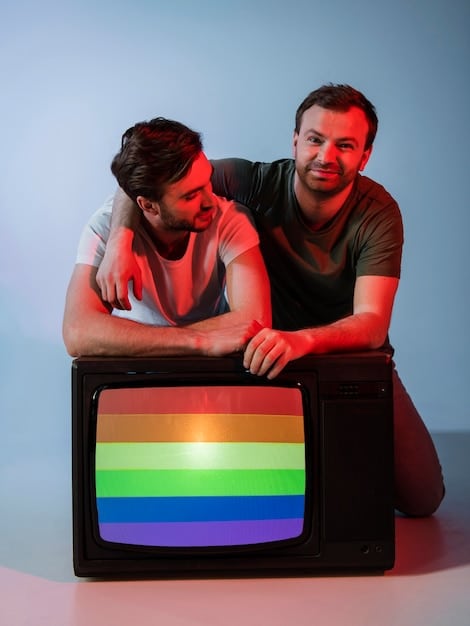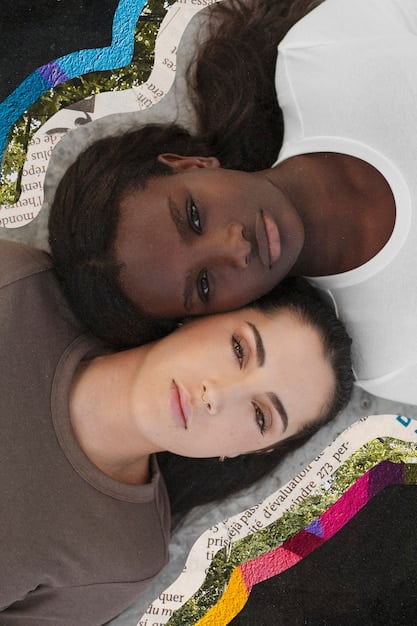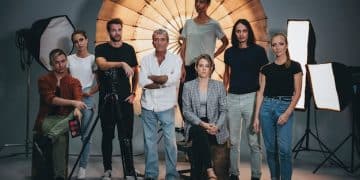LGBTQ+ Representation in Film: Recent Progress & Future Directions

The representation of LGBTQ+ characters in film has seen progress in recent years, yet challenges persist in achieving authentic and diverse portrayals that reflect the community’s multifaceted experiences.
The silver screen has long been a mirror reflecting society’s values, biases, and aspirations. When it comes to the representation of LGBTQ+ characters in film: a review of recent progress reveals a complex tapestry of victories, setbacks, and ongoing battles for authentic storytelling.
The Evolution of LGBTQ+ Representation in Cinema
The portrayal of LGBTQ+ individuals in film has undergone a significant transformation over the decades. From coded characters and stereotypical villains to nuanced protagonists and empowering figures, the history of queer representation on screen reflects broader societal shifts. But how far have we truly come?
Early Representations: Erasure and Stereotypes
Early cinema often relegated LGBTQ+ characters to the margins, portraying them as figures of ridicule, tragedy, or danger. These portrayals not only reinforced societal prejudices but also contributed to the erasure of queer identities from mainstream narratives.
The Rise of Independent Cinema and New Queer Cinema
The emergence of independent cinema and the New Queer Cinema movement in the late 20th century marked a turning point, providing a platform for LGBTQ+ filmmakers to tell their own stories. Films like “Philadelphia” and “Go Fish” challenged mainstream stereotypes and offered more complex and authentic perspectives.
- Breaking Stereotypes: Moving beyond caricatures and tropes.
- Authentic Voices: LGBTQ+ filmmakers telling their own stories.
- Challenging Norms: Confronting societal prejudices through cinema.
This shift towards authentic voices and nuanced portrayals was crucial, but challenges remained concerning diversity and intersectionality within LGBTQ+ representation.

Modern Milestones: Progress and Pitfalls
The 21st century has witnessed increasing visibility and acceptance of LGBTQ+ individuals in mainstream media, including film. However, progress hasn’t been uniform, and certain pitfalls persist in the representation of queer characters.
Box Office Success and Mainstream Visibility
Films like “Love, Simon” and “Booksmart” have demonstrated that LGBTQ+ stories can resonate with broad audiences and achieve commercial success. These milestones are a testament to the growing appetite for inclusive storytelling that reflects the diversity of the world.
The Problem of Tokenism and Stereotyping
Despite progress, some films still fall into the trap of tokenism, featuring LGBTQ+ characters as mere sidekicks or diversity checkboxes. Moreover, certain stereotypes continue to plague queer representation, limiting the depth and complexity of these characters.
- Tokenism: The superficial inclusion of LGBTQ+ characters.
- Stereotyping: Perpetuating harmful generalizations about queer identities.
- Lack of Diversity: Ignoring the intersectionality of LGBTQ+ experiences.
Navigating these pitfalls requires a commitment to authentic storytelling, diverse casting, and intersectional representation.
The Importance of Authentic Representation
Authentic representation of LGBTQ+ characters in film is crucial for fostering understanding, empathy, and acceptance. When done right, it empowers LGBTQ+ individuals, promotes inclusivity, and reflects a more accurate picture of the world.
Breaking Down Barriers and Promoting Understanding
Accurate and nuanced portrayals of LGBTQ+ characters can help break down harmful stereotypes and promote understanding among different communities. By humanizing queer experiences, films can bridge divides and foster empathy.
Empowering LGBTQ+ Individuals and Communities
Seeing positive and affirming representations of themselves on screen can be incredibly empowering for LGBTQ+ individuals, especially young people struggling with their identities. These portrayals offer hope, validation, and a sense of belonging.
Ultimately, authentic representation in film goes beyond mere visibility; it’s about capturing the full spectrum of human experience and celebrating the diversity of identities.
Diversity and Intersectionality in LGBTQ+ Stories
One of the major challenges in the representation of LGBTQ+ characters in film is the lack of diversity and intersectionality. Queer identities intersect with race, class, gender, disability, and other aspects of identity, yet these intersections are often overlooked or marginalized.
Addressing the WHITENESS of LGBTQ+ Narratives
Many LGBTQ+ films primarily focus on white, middle-class characters, neglecting the experiences of queer people of color. This WHITENESS not only reinforces existing power structures but also limits the scope and relevance of LGBTQ+ storytelling.
The Importance of Trans and Non-Binary Representation
Trans and non-binary characters are often misrepresented, stereotyped, or altogether absent in mainstream cinema. Increasing trans and non-binary representation, both in front of and behind the camera, is essential for promoting understanding and acceptance.

- Intersectional Storytelling: Exploring the complexities of identity.
- Diverse Casting: Ensuring that LGBTQ+ stories reflect the diversity of the community.
- Amplifying Marginalized Voices: Giving a platform to underrepresented perspectives.
By embracing diversity and intersectionality, LGBTQ+ films can become more representative, relevant, and impactful for all audiences.
Behind the Camera: The Role of LGBTQ+ Filmmakers
The representation of LGBTQ+ characters in film is not solely dependent on what happens on screen but also on who is telling the stories. LGBTQ+ filmmakers bring unique perspectives, experiences, and sensibilities to their work, resulting in more authentic and nuanced portrayals.
Empowering LGBTQ+ Voices and Perspectives
When LGBTQ+ filmmakers are in control of the narrative, they can ensure that queer characters are portrayed with dignity, respect, and complexity. They can also challenge harmful stereotypes and offer alternative perspectives that are often missing from mainstream cinema.
Promoting Diversity and Inclusion in the Industry
Supporting LGBTQ+ filmmakers also means promoting diversity and inclusion within the film industry as a whole. By creating opportunities for queer talent both in front of and behind the camera, we can foster a more equitable and representative industry.
In essence, empowering LGBTQ+ filmmakers is not just about telling better stories but also about building a more inclusive and just society.
Looking Ahead: The Future of LGBTQ+ Representation
As we look to the future, the representation of LGBTQ+ characters in film holds immense potential. By building on recent progress and addressing existing challenges, we can create a more inclusive, authentic, and empowering cinematic landscape.
Pushing Boundaries and Challenging Norms
Future LGBTQ+ films should continue to push boundaries and challenge norms, exploring unconventional narratives, complex characters, and daring themes. By taking risks and pushing the envelope, filmmakers can expand our understanding of queer experiences.
Fostering Collaboration and Dialogue
Constructive discussions about the portrayal of LGBTQ+ characters in the film industry are critical. These dialogues can help ensure sensitivity and thoughtfulness in how stories are crafted and brought to life.
The future of LGBTQ+ representation in film is not predetermined. It’s up to filmmakers, actors, activists, and audiences to shape it into something truly transformative.
| Key Point | Brief Description |
|---|---|
| 🎬 Early Erasure | Initial film portrayals were often stereotypical and marginalizing. |
| 🌈 Indie Breakthroughs | Independent cinema provided platforms for authentic LGBTQ+ stories. |
| 🌟 Mainstream Milestones | Films like “Love, Simon” achieved box office success, increasing visibility. |
| ✊ Future Directions | Promoting diversity, intersectionality, and LGBTQ+ filmmakers for better representation. |
Frequently Asked Questions
▼
Representation in film is crucial because it shapes perceptions, promotes understanding, and provides validation for underrepresented groups. It allows individuals to see themselves reflected in media and fosters empathy among diverse communities.
▼
Common stereotypes include the flamboyant gay man, the tragic lesbian, the predatory bisexual, and the confused transgender person. These stereotypes can be harmful because they reduce complex individuals to simplistic caricatures.
▼
Filmmakers can improve LGBTQ+ representation by consulting with LGBTQ+ individuals, hiring diverse writers and actors, and creating nuanced characters that avoid stereotypes. Authenticity and sensitivity are key to positive portrayals.
▼
Intersectionality recognizes that identities intersect and create unique experiences. It’s important in LGBTQ+ representation to acknowledge how race, class, gender, and other factors shape queer individuals’ lives, avoiding a one-dimensional view.
▼
LGBTQ+ filmmakers bring authentic perspectives and experiences to their stories, challenging stereotypes and promoting inclusivity. Their involvement ensures that queer characters are portrayed with dignity, respect, and complexity, resonating more profoundly.
Conclusion
The representation of LGBTQ+ characters in film: a review of recent progress shows that while progress has been made in recent years, it is imperative that continued efforts are put forth in all present and future productions to continue the push for visibility, diversity, and authentic storytelling.





